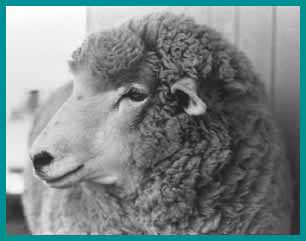Ericka: the Perfect Corriedale Ewe

Ericka: the Perfect Corriedale Ewe
The Corriedale also produces a high quality carcass, and so is called a "dual-purpose breed" in that it produces a quality, large fleece, as well as a good market lamb.
Typically, (the original breed or old style) was a medium sized sheep: ewes were 125 to 175 pounds and rams were 250 to 275 pounds, and each animal would annually produce a 14 pound to 20 pound unskirted fleece. The fleece may range in grade from a low 1/4 blood to high 1/2 blood or in spinning count from 46 to 62's - quite a large range, making fleece grade a very individual thing. All of the fleeces are known for their pronounced and even crimp which makes them extremely elastic when spun, and quite lofty and soft when washed after spinning. Staple length is from 3 1/2 to 5 inches long, and in general one could say that the longer the staple, the coarser the grade will be, although there is that rare individual who will produce a 5 inch 64 count fleece. (A real treat to spin!)
Their head and face are distinctive, being all white with black nostrils; they are never wool blind, and never horned. They also have black hooves - a characteristic that was believed to indicate a stronger hoof, resistant to hoof rot.They are known to be long-lived, consistently produce twins, and are very possessive, caring mothers. A thing which non-sheep-people may not know, is that as the ewe goes into the later stages of labor, she will begin to "talk" to the unborn lambs and call to them. Not unlike people, some talk non-stop while others talk a little less, but they all call until the lambs are born. After the lambs are born there is a good deal of "worfling" that goes on - not baaing, but worfling, until the lambs get organized and nurse. In addition to knowing their moms by smell, the lambs also know their mom's voices and so respond when they are called. They have two breeding seasons: in the Spring and in the Fall, but *may* also breed out of season. |

|
Purebred white Corriedales may be registered with the American Corriedale Association. There is no coloured Corriedale registry. You may contact the Association by writing to: Marcia E. Craig, Executive Secretary, P.O. Box 391, Clay City, Illinois 62824 or (618)676-1046.

|
Gleason's Fine Woolies are located in the foothills west of Lyons, off of Hwh 36 towards Estes Park, Colorado on an eighty acre farm. Life here is a bit of a challenge, with everything being either hauled up or down miles of bad mountain road.
|
Then there are the lions and coyotes, and bears - OH MY! If it were not for our Pyrenees: Marley and Badger, and our Maremmas: Cracker and Jack, our flock of 80 ewes and rams could not be here. In the Spring after lambing, there are often another 120 or so sheep on the place. In point of fact, the golden eagles are as much of a threat to the new lambs as are the usual predators. New lambs must be watched while in the pasture until they all weigh twenty pounds or more, lest the eagles carry them away. We have been quite lucky so far, and feel that it is a privilege to be here. [an error occurred while processing this directive]